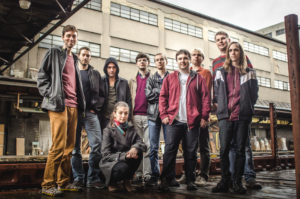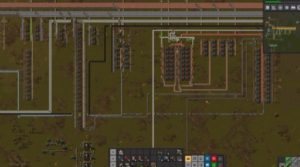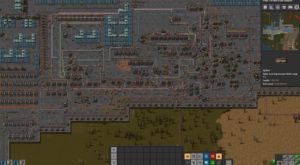Factorio is a game about laziness. It’s about getting from point A to point B with as little effort as possible. This seemingly simple task becomes complicated, however, because point B is in space, and you need a rocket to get there. Therefore, you – an unnamed engineer stranded in an unnamed hostile world – must build from scratch a production facility to produce the research and rocket parts to escape your inhospitable environment using nothing but your own two hands, a pickaxe, and magic conveyor belts that run without being connected to electricity.
Factorio is a tile-based building game from the team at Wube Software. Based in Prague, Czech Republic, Wube employs just 20 people, and Factorio is its only game. Wube released Factorio in 2012 and has improved upon and added to the game since that time, collaborating with an artist from Austria and a 3D specialist from Lithuania.

The main goal of Factorio is stated to be the researching and launching of a rocket, but it’s really to keep expanding your factory to produce more products, fight more aliens, conduct more research, and cover the entire world in concrete. This game is one of the best examples of player-driven goals, as aside from the ultimate goal of finishing the rocket; every task in the game can be handled at any time.
You could build a setup that only produces the handful of products necessary to finish the game, but then you would miss out on the awesome creativity the game allows. The fun of the game is that as you build your rocket, you design your own ways to solve challenges you face. For example, you might decide to automate the production of common buildings, which cuts out the hassle of crafting a new batch of structures every time you need to expand. You might decide to walk everywhere you need to go, or you could decide to lay conveyor belts that don’t carry any items but rather serve to speed up your movement along common routes through your factory. You could clear trees out of the way by hand, or you could craft a flamethrower and get the job done much, much faster. It’s in this way that Factorio really excels at taking advantage of the player’s own laziness to motivate them to find solutions that are faster, more efficient, or simpler to build, because the developers know that the game is at its most interesting when the player is figuring out how to produce their next product with maximum efficiency.
Perhaps the best feature of Factorio is its adaptability. You could obsess over ideal ratios and max efficiency, or you simply could make sure you have “enough” raw materials for whatever it is that you want to produce. No setup, no matter how convoluted and inefficient, is unworkable, and the only ceiling on your total production is how much your computer can handle before starting to strain. I have personally followed the development of this game since I was in 7th grade, and I have moved through most of the types of factory layouts from least to most organized.

This is part of a factory I built in the current most recent version, 0.17.15

And this affront to engineering is part of a factory I built two years ago in version 0.15.24. Several years ago I built a factory that was actually less comprehensible that the 0.15.24 factory shown here, but that version of Factorio from is incompatible with my current version of MacOS, so, unfortunately – or perhaps, fortunately – I’m unable to show you how terrible that factory was.
The developers of Factorio are highly active in the community, and they release a “Factorio Friday Facts” every week which details what they accomplished that week, their plans for future content patches, previews of unstable builds of the game, and developer commentary on patch notes and certain design choices. In fact, as content-rich as Factorio is, it’s still in early access, but due to the developers’ high standards of stability before pushing out each update, it feels like a finished game that occasionally gets a content patch.
I give Factorio
Like it/Love It/Gotta Have It
